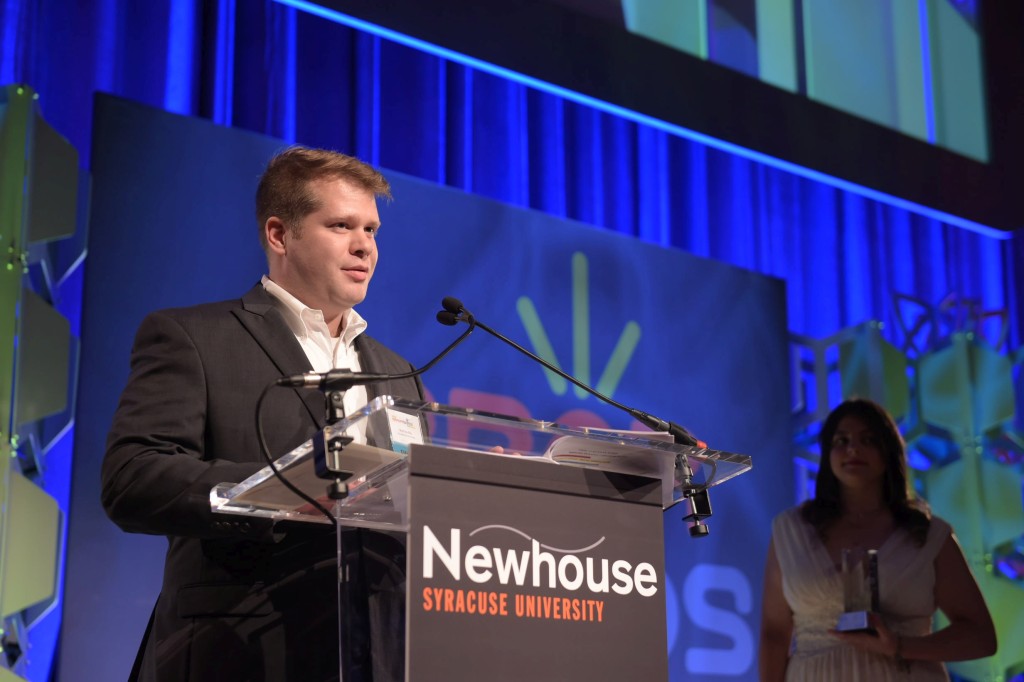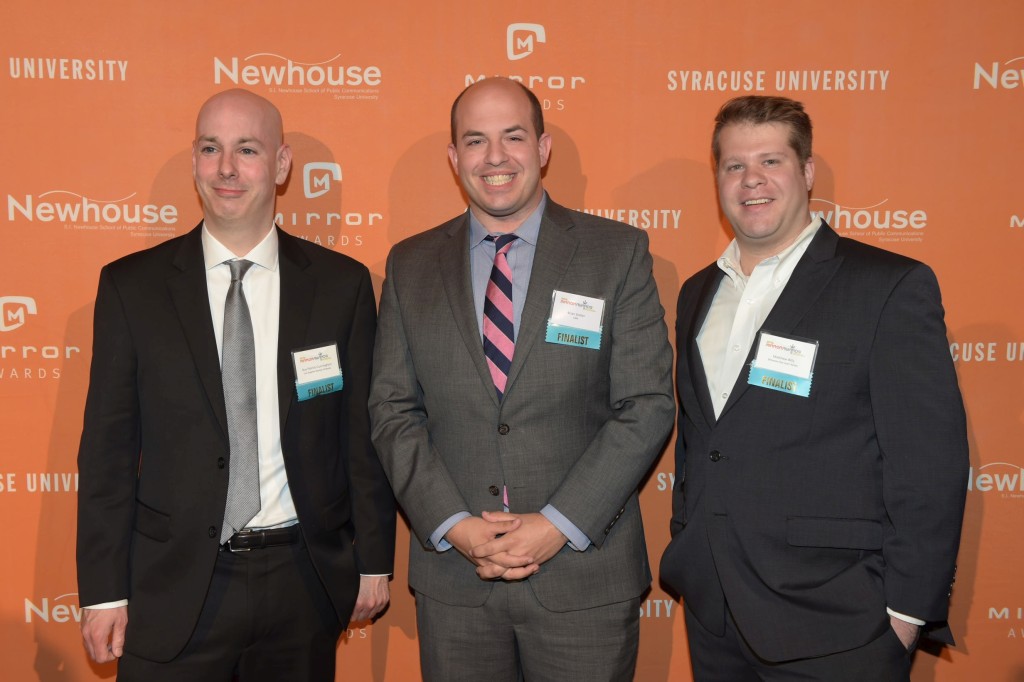Matthew Billy talks about the history of ad-jingles on The Takeaway
Between the Liner Notes Wins a Mirror Award
Between the Liner Notes's third episode "I Want My MTV" took home the Mirror Award for "Best Single Story – Radio, Television, Cable or Online Broadcast Media". The ceremony took place at Cipriani 42nd Street Thursday, June 9th 2016. Established by Syracuse University’s S.I. Newhouse School of Public Communications, the awards honor the reporters, editors, broadcasters, podcasters and teams of writers who hold a mirror to their own industry for the public’s benefit. Click here to view the Mirror Awards's website


Between the Liner Notes Joins Goat Rodeo
Jack White, the Mob & the Seven-Foot Tall Music Video Jukebox
During my last visit to Nashville, I decided to take a walk.
I purchased a venti iced-coffee from a Starbucks near my Airbnb and strolled past the honky-tonks, bachelorette parties and hurly-burly of Broadway until I had wandered a mile to Jack White’s record store, Third Man Records. I admit I didn't know much about the store; my only exposure to Third Man Records came from a segment on the Colbert Report where Steven recorded the song "Charlene II (I'm Over You)." The nerd-receptors in my brain were not prepared to encounter the rare specimens of antique (but fully functional) technology Jack White keeps inside. For a little money, any visitor can record themselves on a refurbished 1947 Voice-o-Graph machine, manufacture a bright red wax mold of White’s Airline guitar with the Mold-a-Rama, or play music videos on a coin-operated machine called the Scopitone. I found this music video jukebox from the mid-60s to be the most intriguing device of the bunch.
If a Wurlitzer Jukebox and an old tube television had a love child, it would look like the Scopitone. The machine is seven feet tall with a 26-inch screen you have to bend your head upward to watch. In its gut are 36 3-minute films loaded into a rotating drum. In the mid-1960’s, anyone could pay a quarter to project any of the 36 films onto the screen. Little did they know that they were watching a forerunner of the modern music video.
The Scopitone was designed by a French company named Cameca, which is often described as the French RCA. Cameca manufactured these machines and began placing them in bars, restaurants and coffee shops. The company commissioned some of France's biggest pop stars to make videos for the Scopitone, and soon people began frequenting their favorite establishments specifically to watch music videos on the machine.
The success of the Scopitone in France didn’t go unnoticed in the United States. In 1961, an unlikely consortium of businessmen, the William-Morris Talent Agency, and some alleged associates of the Genovese crime family, secured distribution rights for the United States territory and formed Scopitone Inc. By 1964, this consortium had imported plenty of Scopitones from France, but supply was not keeping up with demand. They needed a manufacturer in the United States to churn out Scopitones at a much faster pace, so they sold an 80% share of Scopitone Inc. to Tel-A-Sign a Chicago based company that manufactured large illuminated plastic signs for businesses like gas stations and supermarkets. It's hard to tell if Tel-A-Sign was aware of the Genovese crime family's involvement in Scopitone Inc., but in retrospect, the deal resembles a Faustian bargain.
Before the ink on the contact was dry, Tel-A-Sign announced grandiose plans to begin manufacturing thousands of Scopitones, projecting they would be making 10,000 per year by 1966. They brokered exclusive deals with regional distributors, who placed the machines in bars, restaurants and hotel lobbies. Pretty soon, business was booming. One year later, in 1965, Tel-A-Sign’s gross income doubled, and their net income increased by a multiple of seven. Manufacturing illuminated plastic signs was no longer their core business.
The Scopitone's success came in-spite of its prohibitive price tag. The base price was $3,500 plus an additional $720 for leasing the first 36 films. After the initial leasing fee, there was a fee of $60 per month which paid for updating the film library with new material. Today, $3,500 would equal more than $26,000. You might think the high initial investment would deter establishment owners from buying a Scopitone, but it seems the investment was justified. Owners reported making up to $375 per week off the machine, so the initial costs could be recouped in about three months.
Unlike in France, no one in the United States went to a bar specifically to plonk quarters into a Scopitone and stand there watching a music video. The video directors were aware of this, so they loaded the films with an abundance of scantily clad women (by mid-60’s standards) doing suggestive dances (also by mid-60’s standards) with hopes of attracting the stare of some man sitting alone at the bar and entice him to pay to watch another video. One of my favorite examples of a Scopitone film is Neil Sedaka’s “Calendar Girl” which features an attractive women in a fresh and fashionable outfit (by mid-60s standards) for every month of the year. It also gave Neil a chance to display the breadth of his dinner jacket collection.
Calendar Girl aside, there was a general lack of films for the American audience. Film creation was not keeping up with the rapidity with which the top 40 music chart evolved. Frequently, the films inside the Scopitone were for songs that were outdated. Those films were supplemented with French films featuring musicians unknown in the United States and in a language most Americans did not understand. Tel-A-Sign hoped to remedy this film shortage by hiring a company called Harman Enterprises, a production company partially owned by singer/actor Debbie Reynolds, who was the female lead in Singing in the Rain. Harman Enterprises agreed to produce 48 Scopitone films per year, including films featuring Debbie Reynolds.
Their partnership may have been successful if Tel-A-Sign's skeletons were never dragged out of the closet. While Tel-A-Sign was enjoying windfall profits and Haman Enterprises was ramping up production, the Scopitone’s association with organized crime began to catch up with it. In 1964 the Justice Department, then helmed by Robert Kennedy, began looking into the original deal brokered between the business consortium and Tel-A-Sign. Two years later, in 1966, when the Justice Department felt it was getting close to handing out indictments, someone leaked the investigation to the Wall Street Journal. They printed an article about the investigation, which sent the Tel-A-Sign stock into a tailspin. In a Faustian bargain, the devil always comes to collect.
On May 4th, smack in the middle of the fallout from the Wall Street Journal article, Tel-A-Sign's CEO resigned. In the press release, the former CEO emphatically denied the article had anything to do with the decision. Around the same time, Tel-A-Sign was beginning to have money problems. They had given their trusted West Coast Scopitone distributor a substantial number of Scopitones on credit and that trusted distributor failed to pay them back. Things just spiraled downward from there. Soon, Tel-A-Sign stopped filing quarterly reports with the Securities and Exchange Commission, who responded by de-listing Tel-A-Sign stock from all stock exchanges. Then on August 9th, 1967 Tel-A-Sign’s cash-flow problems forced them to file for chapter 11 bankruptcy (that's the restructuring bankruptcy).
Soon production of new Scopitone films came to a halt. The machines themselves began to be sold in classified sections of newspapers for well under the list price of $3,500. One investor decided to purchase the Scopitone distribution rights and film catalog in the restructuring process, but nothing ever came of it. Debbie Reynolds's company, Harman Enterprises, lost everything they invested into making films. According to Scopitone collector Bob Orlowsky, many people have tried to interview Debbie Reynolds about her failed investment, but she has no interest in discussing it.
For all the media attention and damage to Tel-A-Sign’s reputation the Justice Department caused, they ended up dropping their case. The only person to receive a conviction was Genovese associate Vincent Alo (Jimmy Blue Eyes) for giving false and evasive answers under oath. Finally, Tel-A-Sign, mired in lawsuits, fizzled out and the public’s interest in music videos died with it. The music video as a form of entertainment wouldn't catch on in the United States until the success of MTV over a decade later. You can hear that story on episode 3 of the Between the Liner Notes podcast entitled "I Want My MTV."
Whether it was the organized crime allegations or extending a line of credit to the wrong person that ultimately ended the Scopitone’s short reign is not completely agreed upon. However, it is known that when Tel-A-Sign folded in 1969, the Scopitone went from being a promising new technology to a technological dinosaur fit for ownership only by nostalgic collectors...and Jack White. His Scopitone sits in Nashville’s Third Man Records like a museum piece reminding people of a past they barely remember or were never aware existed. When I was there, most of the patrons walked by the Scopitone, not knowing what it was, and not really all that curious. They were much more intrigued by the vintage wax disc recorder.
I, however, am intrigued by technological dinosaurs, so before I left, I bought a token from the girl at the checkout counter and plunked it into the Scopitone. I selected a video (Jack White loaded the machine with contemporary videos released by his record label) and watched. Having checked off one more item on my bucket list, I finished my venti iced coffee and wandered into the Nashville streets, back towards the hurly-burly of Broadway with a smile on my face.
By Matthew Billy (Host of the BetweenTheLinerNotes.com podcast)
The Pythagorean Comma's New Found Popularity
The mathematical anomaly called the Pythagorean Comma is not a typical topic for podcasts. In fact, it's not a common topic for any medium, aside from the academic paper written for an audience of music theory intelligentsia. So of course I thought Between the Liner Notes was being unique when we covered the Pythagorean Comma in episode 2: The Tuning Wars. To my shock (but not chagrin), on September 1st, the very same day episode 2 was released, I saw this tweet from @e_antczak:
Curiosity firmly piqued, I began investigating and discovered that The Black Tapes podcast, a serialized mystery docudrama, had written the Pythagorean Comma into episode 109: Name that Tune, which was also released on September 1st. The Black Tapes used the Pythagorean Comma and the Roman Catholic Church's opposition to dissonance as the engine driving episode 109's mystery. Imagine if a music theory nerd wrote the Da Vinci Code and you would get something like this Black Tapes episode.
I can understand why @e_antczak thought the two podcasts were colluding and planned this beforehand, but we were not. Neither of us was aware of the other existed let alone aware of our respective next episodes. After @e_antczak's tweet went out, The Black Tapes responded:
and then...
After finishing listening to Black Tapes ep 109 I responded:
The odds that two podcasts would release episodes about the Pythagorean Comma on the exact same day are slim but the universe works in unpredictable ways. It's like the Pythagorean Comma was already sounding in the ether, waiting for a few people to catch the sympathetic vibrations.
...and thanks @e_antczak for pointing the coincidence out to us who pretty much summed everything up with this tweet:
By Matthew Billy (BetweentheLinerNotes.com)
How Powerful is Justin Bieber’s Twitter Account?
“Call Me Maybe by Carly Rae Jepson is possibly the catchiest song I’ve ever heard lol” Justin Bieber tweeted one day before New Year’s Eve, December 30th, 2011 and soon his followers retweeted the message 15,931 times, providing the initial inertia to get Carly Rae Jepsen’s career in the United States rolling along. Then with the support of traditional media and later radio airplay “Call Me Maybe” built up enough momentum to reach the number one spot on the Billboard Hot 100 and took up residency there through the summer.
Like boulders, music careers all begin at rest and require a tremendous force to move. Once rolling, the force needed to accelerate the boulder is less than the force needed to move it initially. Normally, that initial force requires exposure in many media outlets and a lot of money but Bieber applied that kind of force in the time it takes to compose a 140 character message and for free.
The Bieb’s Twitter following soon became a news story. Articles in periodicals like The New York Times and New Yorker magazine featured quotes by top publicity gurus all confirming that the reach of Bieber’s Twitter account is remarkable. When Barry Lowenthal, who’s company Media Kitchen worked with Justin to release his perfume Girlfriend was asked about Bieber’s social media reach he replied, “Can you imagine what it would cost to reach more than 40 million people in mass media today? Ten million dollars, if that audience were reached through three commercials on the season finale of American Idol.” The 40 million number refers to Justin’s reach across multiple social media platforms but the point remains the same; Justin Bieber’s social media reach is a force to be reckoned with.
With most of us having only a few hundred Facebook friends, the power of Bieber’s Twitter account boasting 30,951,150 followers (as of 12/02/2012) is difficult to fully comprehend however, when compared to the Arbitron ratings, Nielsen ratings and subscription numbers used to analyze traditional media its power becomes clearer.
An appearance on a late night talk show is one of the most coveted opportunities for musicians. Landing one is difficult and requires the expertise and network of a highly skilled, highly paid publicist. The most popular of these shows is the Tonight Show with Jay Leno averaging approximately 3.6 million viewers each night. The second most popular is the Late Show with David Letterman averaging 3.2 million viewers per night. Jimmy Kimmel averages 1.8 million, The Daily Show averages 1.4 million and Conan O’Brien averages 1 million viewers. All of these shows air simultaneously and if an artist were to appear on all of them in the same night, the artist would reach a total audience of 11 million viewers or roughly 36% the number of people who follow Justin Bieber on Twitter.
Radio continues to be the most popular way people discover new music. “Call Me Maybe” didn’t become a number one song until terrestrial radio stations began spinning it but still, even if a song was played once on every radio station in the largest radio market in the United States (including the talk & sports stations) it would only reach an audience a fraction of Bieber’s Twitter following. That radio market, the New York metropolitan area, contains 15.8 million listens above the age of twelve. Los Angeles being the second largest contains 11 million. Radio listeners don’t surpass Bieber’s Twitter following until Chicago, the third largest, is combined with L.A. and New York for a total of 34.6 million listeners. Even Rush Limbaugh’s talk show which has a stronghold on the most listened to syndicated radio show only has a listenership of half of Bieb’s twitter following with 15 million listeners.
The picture doesn’t change much with print media in the United States. An artist would need to be in The Wall Street Journal (2.1 million subscribers), USA Today (1.8 million), The New York Times (1.6 million), Rolling Stone Magazine (1.5 million), People Magazine (3.6 million), Time Magazine (3.3 million), Cosmopolitan (3 million), Maxim (2.5 million), O, The Oprah Magazine (2.4 million), Seventeen (2 million), Us Weekly (2 million), Entertainment Weekly (1.8 million), Newsweek (1.5 million – though soon shutting down their print edition), and The New Yorker (1 million) to have a reach of over 30 million readers. The only periodical that has a circulation comparable to Bieber’s Twitter following is the AARP Magazine which boasts a circulation of 22.5 million and their core demographics are at complete opposite ends of the age spectrum. These numbers represent the physical circulation of each periodical and don’t factor in views of their websites.
Maybe the song would not have spent nine weeks at number one if it were not expertly composed, produced, performed, mixed and mastered. Maybe a twitter following is not perfectly equivalent to a magazine or newspaper review, radio spin or live performance on a late night talk show. And maybe the Bieber tweet was just one large dot in the connect the dots puzzle that became the picture of “Call Me Maybe”‘s success but never the less, Justin Bieber, who isn’t even old enough to down a Miller Lite in the United States, has the ability to reach nearly one-tenth of the country from his mobile phone while eating breakfast and it doesn’t cost him a dime. I call that – maybe – a game changer.
By Matthew Billy (BetweenTheLinerNotes.com)









